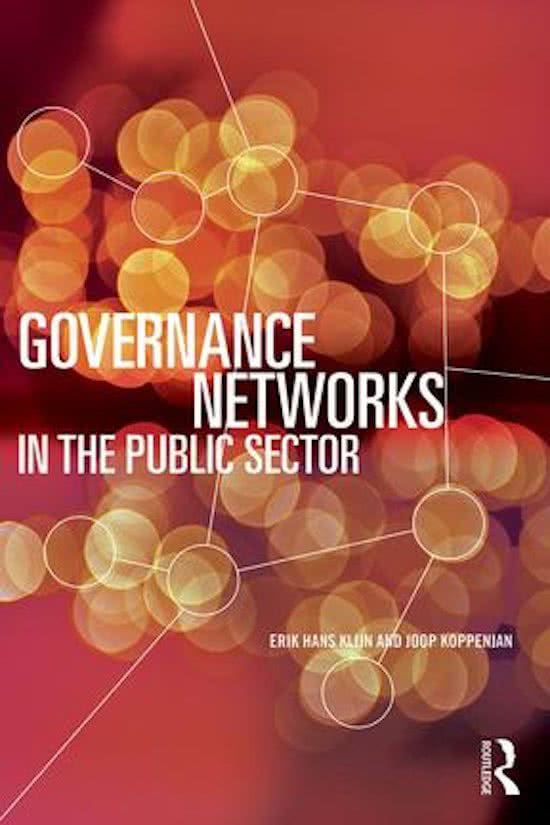Network Governance
Week 1 Introduction.................................................................................................................... 1
1 Governance networks in the public sector: an introduction.................................................. 1
Week 2 Substantive Complexity.................................................................................................4
12.1 Introduction: Knowing the network...................................................................................4
12.2 Actor Analysis.................................................................................................................. 5
3 Substantive complexity in governance networks.................................................................. 7
Week 3 Strategic Complexity....................................................................................................12
4 Strategies, games, rounds and arenas...............................................................................12
12.3 Process analysis............................................................................................................21
Van den Berg (2020), The Young Diplomat........................................................................... 24
Chapter 1 Everyday diplomacy........................................................................................ 24
Chapter 4 What is at stake?.............................................................................................26
Week 4 Institutional Complexity...............................................................................................28
5 The institutional complexity of governance networks......................................................... 28
8 Managing institutional complexities in governance networks............................................. 36
12.4 Institutional analysis: analysing the institutional structure of the network......................39
Week 5 Network Management.................................................................................................. 41
6 Managing substantive complexities in governance networks............................................. 41
7 Managing strategic complexities in governance networks..................................................48
Week 6 Evaluation..................................................................................................................... 57
11 Evaluating governance networks...................................................................................... 57
13 Wrapping things up and looking ahead............................................................................ 61
Week 7 Normative Aspects.......................................................................................................70
9 Governance networks and democracy............................................................................... 70
10 Governance networks and accountability......................................................................... 76
,Week 1 Introduction
1 Governance networks in the public sector: an introduction
- Government, business, and civil society in our contemporary network society are
increasingly faced with complex societal problems.
- Attempts to deal with these problems may result in enduring processes of policy making,
policy implementation, and public service delivery that are hard to manage.
- Problems are characterised by a high degree of wickedness: difficult issues that require
in-depth knowledge on their nature and possible solutions; they also, however, involve
many actors, and this may result in a chaotic process with unexpected and unwanted
outcomes.
1.2 Government, governance, and governance networks: a conceptual clarification
Government: the Traditional Public Administration Model
- Government refers to public problem solving, policymaking, and service delivery
according to the Traditional Public Administration Model.
- In this model, problems, policies, and services are assigned to specialised governmental
units. Integration and coordination is realised by command and control within the
bureaucracy, characterised by task differentiation and procedures.
- Within Western democracies, the political decisions regarding problems, policies, and
services are taken by elected administrators at the top of the bureaucracies, who in turn
are held accountable by representative bodies of elected politicians.
- Problems: controlling budgets, motivating civil servants, coordinating units and policies
from the centre, and delivering coherent and integral policies and services that meet the
growing pluralistic and dynamic needs of increasingly assertive clients and citizens and
of the society as a whole.
What is governance?
- Governance as good governance or corporate governance.
- Governance as New Public Management - the role of governments is to steer rather than
to row.
- Government should set goals and formulate policies. The implementation of
policies and the delivery of services are best left to other organisations or
separate public agencies that can be held accountable through the use of clear
performance indicators and other market mechanisms, like contracts,
competition, and benchmarks.
- Governance as network governance.
- Some authors writing on governance consider the concepts of governance and
the network to be tightly connected.
- Governance takes place within networks of public and non-public actors, and the
interaction between these groups makes processes complex and difficult to
manage.
1
, - Book concludes governance should be understood as governance networks. Surprise!
1.3 Defining networks and network governance
- Governance is the process that takes place within governance networks.
- Networks are characterised by complex policy problems that cannot be solved by one
actor alone, but require the collective actions of several actors.
- Governance networks: stable patterns of social relations between mutually dependent
actors, which cluster around a policy problem, a policy programme, and/or a set of
resources and which emerge, are sustained, and are changed through a series of
interactions.
- Governance network processes: all the interaction processes within governance
networks addressing a specific problem, policy, programme, or public service.
- Network governance: the set of conscious steering attempts or strategies of actors within
governance networks aimed at influencing interaction processes and/or the
characteristics of these networks.
- By applying these strategies, actors within networks produce outcomes in terms
of solutions, policies, and services. They do so without conscious attempts at
steering from a non-partial or meta perspective. In this sense, these processes
are self-governing (compare Kooiman 1993).
- Network management: all the deliberate strategies aimed at facilitating and guiding the
interactions and/or changing the features of the network with the intent to further the
collaboration within the network processes.
1.4 Complexity in governance networks
- Complicatedness applies to a technical or social phenomenon or system that consists of
many components that interact in a complicated way with one another.
- Complexity goes beyond complicatedness because it refers to dynamics within systems.
- Substantive complexity within governance networks is not so much caused by the
complicatedness of problems and lack of information and knowledge.
- Rather, it is caused by the uncertainty and lack of consensus over the nature of
problems, their causes and solutions.
- Strategic complexity in governance networks springs from the strategic choices actors
make with regard to problems, policies, and services.
Institutional complexity
- Complex problems, policies, and services often cut across the existing demarcations
between organisations, administrative levels, and networks.
- Interactions between different actors is difficult because each is informed by their
pre-existing outlooks, values, organisational arrangements, rules, administrative levels
and networks.
- Thus, interaction in governance networks is characterised by clashes between
divergent institutional regimes and displays institutional complexity.
2
, - Consequently, for all actors, there is a high degree of uncertainty about how the process
will be handled and what rules will guide the interaction with other actors.
Lecture summary
Traditional Public Administration (TPA)
- Hierarchical steering
- Bureaucratic - emphasis on procedure, solutions are expensive.
- Rational decision-making - idea that you can understand and fix the problem
- Expert input may be required
- Problems:
- Limited government resources: money, knowledge, time etc.
- Limited capacity of single actors to define problems and solutions. Need more
actors to work on the problem holistically.
- Uniform solutions in an increasingly pluralistic society. One solution does not fit
all - needs and values of different groups.
- Imposing decisions invokes resistance. Think pandemic rules, dutch nitrogen
debate (people putting the flag upside down as a sign of resistance).
- High implementation and monitoring costs
New Public Management
- Response to TPA
- Running government as a business
- Steering not rowing
- Setting targets for outcomes. Clear performance targets.
- Market mechanisms: privatisation, competition, contracting
- Arm’s length relationships
- Performance management
- Problems:
- Strong pressure to set goals with ill-defined problems. Might regret the goals,
stuck in a rigid contract.
Network Governance
- No central decision-maker but networks of interdependent actors
- Note: some decisions still remain with the government.
- No central goals, but negotiations and power games
- Lengthy, highly dynamic interaction processes
- Messy and difficult - facilitation and guidance are needed.
- Difficult to secure democratic legitimacy of the process.
Definitions
- Substantive complexity: Actors with different perceptions of problems, solutions, the
status of information and (scientific) knowledge.
- Strategic complexity: Many interacting actors with conflicting interests and strategies.
3





